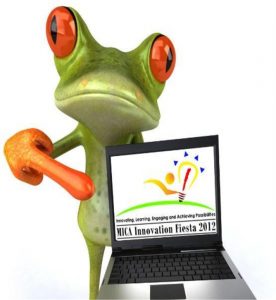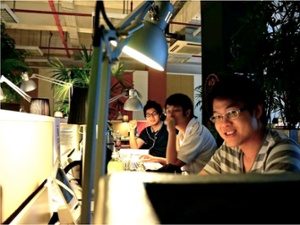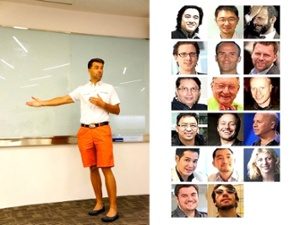 Clean, orderly, polite.
Clean, orderly, polite.
These are the kind of words that first-time visitors to Singapore usually choose to describe the place. So I was intrigued to read that, last week, the country’s prime minister urged Singaporeans to mess things up a little.
Since the amazing performance of JFDI’s startup teams turning ideas into investments in just 100 days, we’ve been asked to share our approach to fast-tracking innovation with all kinds of organizations. It’s made us think about how we’ve learned to live with the mess and uncertainty that’s all part of Lean Innovation and, in this first of a series of posts, I’ll share what we have learned.
Today I was asked to speak at the MICA Innovation Fiesta 2012, writes Hugh Mason. It’s an annual competition held to celebrate innovation by civil servants at Singapore’s statutory boards like the National Libraries, the Infocomm Development Authority and the National Heritage Board. On display were six teams with projects ranging from augmented reality for museums (bringing to life China’s Terracotta Warriors), through online anthologies or personal memories, to a portal sharing Singapore’s public data sets.
Building value in organizations
My brief was to talk about how innovation can build value in organisations. I’m part way through a Masters course about leading innovation and change which has given me the chance to stand back from our day to day work and see it in context. So the opportunity to put JFDI in context and try to summarize something of what we’ve learned in 15 minutes seemed like an interesting challenge.
 Over the last 25 years I’ve been a geek, a film-maker, an entrepreneur and an investor. The common themes have been innovation and the struggle to make a living at it, something that spurred me to co-author a book last year about turning creativity into cash. More recently I’ve thought hard about what it is that builds value from ideas as I watched 11 amazing teams go from idea to investment in 100 days at the JFDI-Innov8 bootcamp.
Over the last 25 years I’ve been a geek, a film-maker, an entrepreneur and an investor. The common themes have been innovation and the struggle to make a living at it, something that spurred me to co-author a book last year about turning creativity into cash. More recently I’ve thought hard about what it is that builds value from ideas as I watched 11 amazing teams go from idea to investment in 100 days at the JFDI-Innov8 bootcamp.
Since it ended and investment offers totalling around S$4 million have rolled in, we’ve been trying to work out how to describe exactly what JFDI is. We run an accelerator program that’s inspired by Y-combinator and TechStars. But that’s only part of it.
For anyone who doesn’t know us, we specialize in creating mobile technology – phone apps and perhaps in the future hardware – and we do it in Asia, for Asia first. So we’re not trying to compete with Silicon Valley but instead to make stuff that fits the way we live here in this part of the world, reflecting our culture and our way of life. We are funded by private investors, sponsors like SingTel Innov8 and to get us going we’re also grateful for support from SPRING’s Incubator Development Program.
Social Capitalists
All of which is necessary and great but – in truth – it’s the social capital in the community around us that’s our real ‘secret sauce’. We seem to have become a kind of innovation academy. We build value because we bring together a community of people who practice innovation, we fund it and we share know how about how to do it.
There are some great companies out there that you can pay to come up with ideas. You take the ideas back to your own business and try to put them into practice. Despite great ideas, the success rate isn’t high, frankly. Most innovation falls down at that final stage – implementation. JFDI is different because we turn ideas into valuable independent businesses, with real paying customers, in 100 days.
That only happens because we recruit some amazing start-up teams. Starting in January this year, we took our first batch through something like basic military training for entrepreneurs (which is why we called it a bootcamp), culminating in a demo day that attracted 110 active investors. Of the 11 start-ups who showed their work, 6 or 7 have got offers of investment. Several have already gone public with announcements and the others will follow once all the paperwork’s signed.
 We invested some money in the start-ups when they joined us but the teams tell us that the real value came from our awesome team of mentors. Among the 50-odd mentors were numerous people who have truly been there and done it before, taking businesses all the way from idea to IPO or a trade sale. They gave us their time and backed us with their cash because – like us – they want to see a new generation in Asia. A generation where today’s inventors become tomorrow’s investors, and today’s company founders become tomorrow’s company funders.
We invested some money in the start-ups when they joined us but the teams tell us that the real value came from our awesome team of mentors. Among the 50-odd mentors were numerous people who have truly been there and done it before, taking businesses all the way from idea to IPO or a trade sale. They gave us their time and backed us with their cash because – like us – they want to see a new generation in Asia. A generation where today’s inventors become tomorrow’s investors, and today’s company founders become tomorrow’s company funders.
Actually, it’s already happening. Local heroes like Darius Cheung (co-f0under of TenCube), Jayesh Parekh (Sony Entertainment Television) and John Bittleston (Cerebos Pacific) gave us time, money or both. They were joined by equally inspiring people from across the region, the US and Europe, thanks to a travel support grant from the MDA.
Their mission was to help our start-up teams prove three things:
- That that they understood some kind of problem in the world that was worth fixing
- That they had a solution for that problem that they could show working as a real prototype
- Finally they needed to show market traction – in other words that people actually wanted the prototype enough to pay for it.
All that in 100 days.
This is the first in a three part series of posts looking at the links between creativity and lean innovation. In the next I will share some of the psychology that’s helped us understand how it works.

